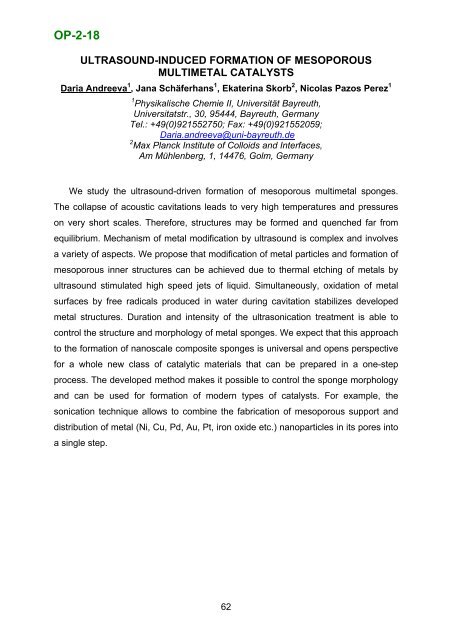Boreskov Institute of Catalysis SB RAS, Novosibirsk, Russia
Boreskov Institute of Catalysis SB RAS, Novosibirsk, Russia
Boreskov Institute of Catalysis SB RAS, Novosibirsk, Russia
- No tags were found...
You also want an ePaper? Increase the reach of your titles
YUMPU automatically turns print PDFs into web optimized ePapers that Google loves.
OP-2-18ULT<strong>RAS</strong>OUND-INDUCED FORMATION OF MESOPOROUSMULTIMETAL CATALYSTSDaria Andreeva 1 , Jana Schäferhans 1 , Ekaterina Skorb 2 , Nicolas Pazos Perez 11 Physikalische Chemie II, Universität Bayreuth,Universitatstr., 30, 95444, Bayreuth, GermanyTel.: +49(0)921552750; Fax: +49(0)921552059;Daria.andreeva@uni-bayreuth.de2 Max Planck <strong>Institute</strong> <strong>of</strong> Colloids and Interfaces,Am Mühlenberg, 1, 14476, Golm, GermanyWe study the ultrasound-driven formation <strong>of</strong> mesoporous multimetal sponges.The collapse <strong>of</strong> acoustic cavitations leads to very high temperatures and pressureson very short scales. Therefore, structures may be formed and quenched far fromequilibrium. Mechanism <strong>of</strong> metal modification by ultrasound is complex and involvesa variety <strong>of</strong> aspects. We propose that modification <strong>of</strong> metal particles and formation <strong>of</strong>mesoporous inner structures can be achieved due to thermal etching <strong>of</strong> metals byultrasound stimulated high speed jets <strong>of</strong> liquid. Simultaneously, oxidation <strong>of</strong> metalsurfaces by free radicals produced in water during cavitation stabilizes developedmetal structures. Duration and intensity <strong>of</strong> the ultrasonication treatment is able tocontrol the structure and morphology <strong>of</strong> metal sponges. We expect that this approachto the formation <strong>of</strong> nanoscale composite sponges is universal and opens perspectivefor a whole new class <strong>of</strong> catalytic materials that can be prepared in a one-stepprocess. The developed method makes it possible to control the sponge morphologyand can be used for formation <strong>of</strong> modern types <strong>of</strong> catalysts. For example, thesonication technique allows to combine the fabrication <strong>of</strong> mesoporous support anddistribution <strong>of</strong> metal (Ni, Cu, Pd, Au, Pt, iron oxide etc.) nanoparticles in its pores intoa single step.62
















